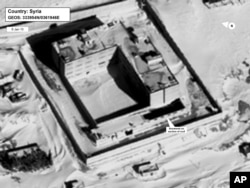Syria's Foreign Ministry is denying U.S. allegations that the Assad government carries out mass killings of prisoners on a daily basis and then burns their bodies in a large crematorium outside the capital of Damascus.
The state-run SANA news agency quoted the ministry calling the U.S. accusation a "Hollywood story detached from reality."
The U.S. State Department said Monday as many as 50 prisoners a day are being hanged at the Saydnaya prison. It alleged that the government of President Bashar al-Assad then is using the crematorium to hide evidence of the extent of the mass killings.
The top U.S. diplomat for the Middle East, Stuart Jones, said Syria "has sunk to a new level of depravity," with the continuing military assistance of Russia and Iran, two countries that have supported the Assad government's six-year fight against various rebel groups attempting to overthrow it. About 400,000 people have been killed in the fighting.
Jones stopped short of accusing Moscow of involvement with the crematorium, saying the State Department had not presented evidence of the mass killings to Russian officials.
But he said the U.S. has "an ongoing conversation with the Russians, talking about the problem that their failure to condemn Syrian atrocities and their apparent tolerance of Syrian atrocities has created. And we have urged the regime–we urged the Russian government to hold the regime responsible for these atrocities."
U.S. President Donald Trump last month ordered a missile attack on Syria after the Damascus regime's alleged chemical weapons assault on civilians.
Asked whether the U.S. is considering a new attack to destroy the crematorium, Jones said that as Trump has said the U.S. is "not going to signal what we are going to do and what we're not going to do. At this point, we are talking about this evidence and bringing it forward to the international community, which we hope will put pressure on this regime to change its behavior."
The State Department official said that "since Syria’s civil conflict began in 2011, the Assad regime has treated opposition forces and unarmed civilians as one and the same -- committing widespread violations of international law, including the law of armed conflict and human rights law.
"Although the regime's many atrocities are well documented," Jones said, "we believe that the building of a crematorium is an effort to cover up the extent of the mass murders taking place in Saydnaya."
He said the U.S. claim is based on information from its intelligence community and credible humanitarian groups.
Jones did not give an official estimate for the total number killed at the Saydnaya facility. But he cited an Amnesty International report that between 5,000 and 11,000 had died at the prison between 2011 and 2015.
He alleged that the Syrian government had detained between 65,000 and 117,000 people over the same four-year period.
"The idea of a crematorium of course has dreadful connotations for those with a memory," Anthony Billingsley, a Mideast lecturer at the University of New South Wales, told VOA. "The idea of massacres in prisons – there was one in Iran, there was one in Libya – it doesn't surprise, and I suspect that the U.S. and Amnesty, who previously reported on this, have reasonably good intelligence about this facility."
The State Department released newly declassified commercial satellite photos of what it said is a building at the prison used as the crematorium.
But the latest photo dated to January 2015, more than two years ago, taken during the administration of former President Barack Obama. It was not immediately clear why the United States waited to present its evidence.












